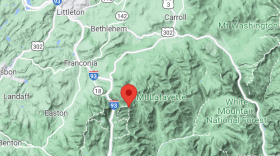More than a North Country mascot, moose are an indicator of ecosystem health and climate change. With populations in New Hampshire decimated in recent years, a four-year, three-state study is collecting data on the health of the moose population and the devastation caused by winter ticks. We discuss other threats to the moose population, such as brainworm, and how moose are managed in the state.
GUESTS:
- Dave Anderson - Director of Education with the Society for the Protection of N.H. Forests and co-host of NHPR's Something Wild.
- Kent Gustafson - New Hampshire Fish & Game Wildlife Programs Administrator.
- Pete Pekins - UNH Professor of Wildlife Ecology and chair of the Department of Natural Resources. He is the N.H. coordinator of the three-state study of winter ticks, with N.H. Fish & Game.
- Keith Roberge - He is a longtime hunter and a licensed moose guide in the North Country.
Scroll down to watch a video of how a moose is collared for the study.
Show Highlights
Dave Anderson of the Society for the Protection of NH Forests, says people care about moose because:
"they are the symbol of wilderness…they are the symbol of the North country. ..moose are emblematic to the people of NH of wild, northern NH."
Professor Pete Pekins says previous studies have seen high mortality rates of moose calves, but not as high or as frequent as the current study shows:
"…we collared 100 animals and the first April 2003 started losing calves in the best habitat possible. It quickly became apparent the tick infestation was off the charts. I distinctly remember there was no winter that year. We had 50% calf mortality then. For the next three years it did not happen again. The major difference this year, and for the last three years, we had 70% mortality of calves."
Many listeners wondered about innoculating the moose while they're being collared for study. Pekins says:
"These animals are not as easy as you might think to be next to, to observe, to stalk…it’s a lot of time and effort just to stalk a cow to see if she had a calf, to follow that animal. There’s a reason we have to hire helicopter crews to come in and catch these animals. These are truly wild animals, and it does raise the other issue. How far do we go…do we take wild out of wild?"
Kent Gustafson, of the NH Fish and Game department, which manages the state's moose population, notes that the tick impacts farther south, even with warm winters, are not as drastic as in the north country. More moose make it hospitable for more ticks:
"It appears as if this density relationship is something worth seriously considering. And it is counter-intuitive. But by reducing densities you may have fewer moose, but healthier moose, and more productive moose."
New Hampshire has abundant habitat for moose, and Pekins does not believe habitat loss is a factor in the moose population's decline:
"The message I want to leave with people is this is not a habitat problem. This is a parasite problem and that parasite is related to longer falls that allow this parasite to have an advantage that may extend into a moderate moose density. And that’s what we don’t know - because this is really new ground that we’re looking at."
NH Fish and Game moose biologist Kristine Rines address questions about threats affecting New Hampshire's moose population, how moose are managed and ways of combating winter ticks.
Examine NH Fish & Game graphs depicting regional moose population changes over time, the changing goals, and the cut?off thresholds for permit suspension.
Read more about N.H. moose and this study in recent article by the New York Times, the Boston Globe and the Concord Monitor.
@JackatSPNHF March 2014 this lovely cow wandered down from the back 40 pic.twitter.com/OzhX0tiVJe
— CininNh (@CininNewH) January 20, 2017














